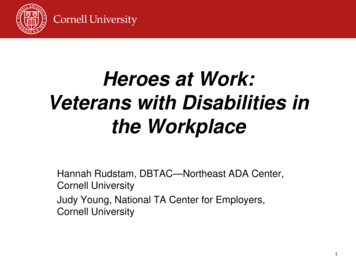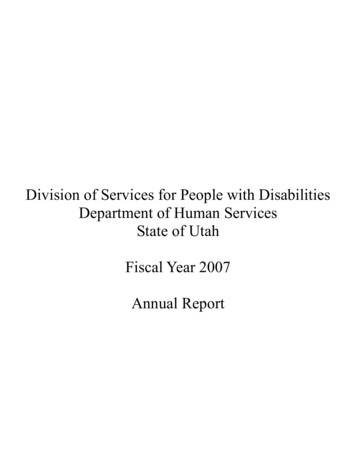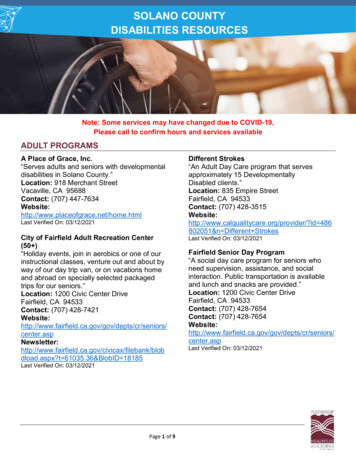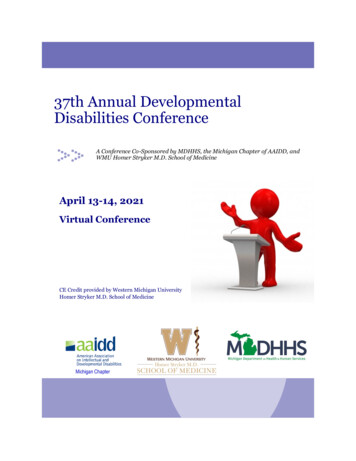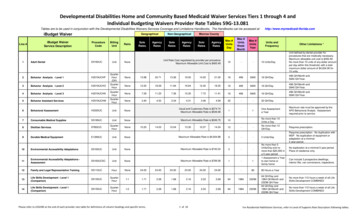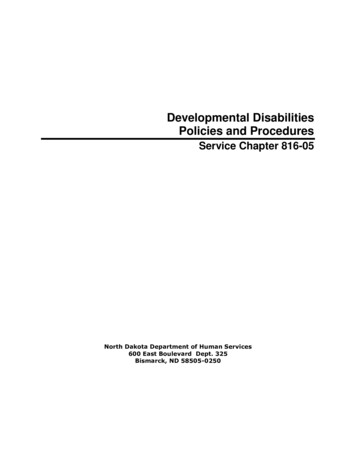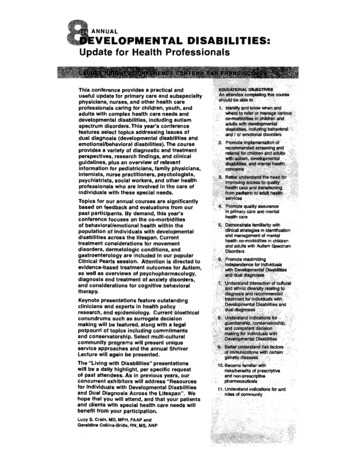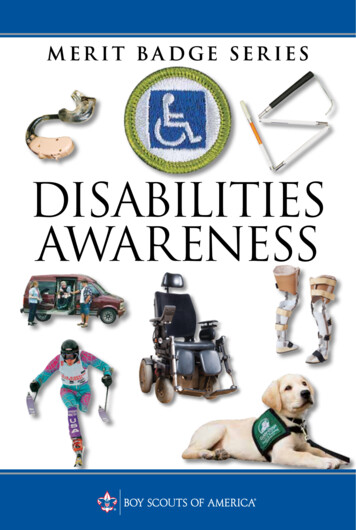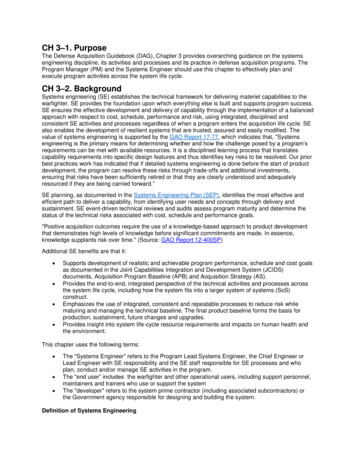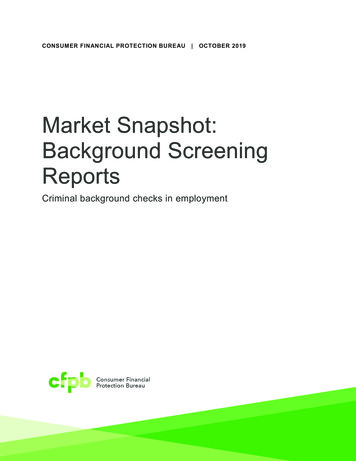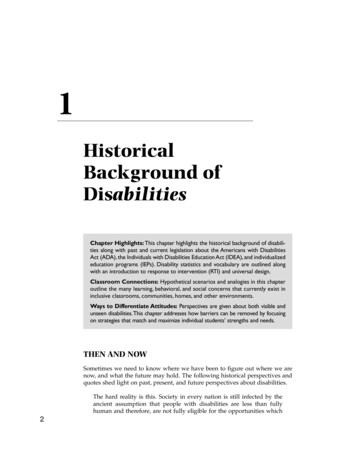
Transcription
1HistoricalBackground ofDisabilitiesChapter Highlights: This chapter highlights the historical background of disabilities along with past and current legislation about the Americans with DisabilitiesAct (ADA), the Individuals with Disabilities Education Act (IDEA), and individualizededucation programs (IEPs). Disability statistics and vocabulary are outlined alongwith an introduction to response to intervention (RTI) and universal design.Classroom Connections: Hypothetical scenarios and analogies in this chapteroutline the many learning, behavioral, and social concerns that currently exist ininclusive classrooms, communities, homes, and other environments.Ways to Differentiate Attitudes: Perspectives are given about both visible andunseen disabilities. This chapter addresses how barriers can be removed by focusingon strategies that match and maximize individual students’ strengths and needs.THEN AND NOWSometimes we need to know where we have been to figure out where we arenow, and what the future may hold. The following historical perspectives andquotes shed light on past, present, and future perspectives about disabilities.The hard reality is this. Society in every nation is still infected by theancient assumption that people with disabilities are less than fullyhuman and therefore, are not fully eligible for the opportunities which201-Karten (Embracing)-45526.indd2 22/27/2008 6:29:51 PM
HISTORICAL BACKGROUND OF DISABILITIES3are available to other people as a matter of right. (Justin Dart, disabilityrights activist, 1992, quoted in DEMOS, 2002)Throughout history, people with disabilities have been treated differentlyfrom those who conform to or fit societal norms. The following bulleted list outlines some of those unfair treatments that were acceptable by different societiesin given time periods. Killed or abandoned in the woods in ancient GreeceKept as jesters for nobility in the Roman Empire courtsExperienced acts of infanticide during the RenaissanceDrowned and burned during the Spanish InquisitionIn 1601, Queen Elizabeth’s government divided the poor into three groups.The disabled poor were placed in the group labeled “helpless poor.”Kept in cellars in correctional institutions in early colonial America if familysupport was not available; people then paid admission to gawk at the oddities.Dehumanization in orphanages and asylums in nineteenth-century EuropePrimary care given by the family at home in the early history of theUnited States instead of children being allowed out in public, e.g., homeschooled and excluded from community activities“Institution for Idiots” founded in Massachusetts in 1848Shackled to their beds in U.S. institutions because there was an insufficient number of staff members to care for residentsInvoluntary sterilization of people with developmental disabilities in theUnited States, beginning in 1907, to prevent the passing on of inferior traitsConsidered by eugenicists as defective and an interference with the process of “natural selection”Gassed, drugged, blood let, and euthanized in Nazi GermanyInstitutionalized regardless of needs, e.g., person with cerebral palsy wasconsidered mentally retardedHoused in separate institutions throughout the worldNot allowed to attend neighborhood schoolsAversion techniques usedSeclusion policies appliedRestraint appliedAbuse prevalent (physical, mental, sexual, financial)Victimized with inhumane treatmentsLives devaluedStigmatized as criminalsViewed as sicklyInaccurately testedInappropriate labels and services renderedDuring World War II, when many jobs were left vacant in the United States,adults with disabilities joined the workforce, showing their competencies, untilreturning soldiers replaced them in the years following the war. Thankfully, duringthe 1960s and 1970s, the civil rights movement began and created an even morefavorable climate for people with disabilities to continue to enter and succeed in theworkforce and beyond. When the inhumane treatment of people with disabilitiesin institutions in the United States was exposed, this laid down a supportive stagefor improving conditions inside and outside of schools for people with disabilities.Eventually, more civil rights and educational laws were passed that consequently01-Karten (Embracing)-45526.indd3 32/27/2008 6:29:51 PM
4INTRODUCING DISABILITIESchanged and expanded services for students and adults with disabilities. This ledto the deinstitutionalization of people with disabilities and altered the way society viewed disabilities in general. Group homes became the norm rather than theexception, and more community integration came to be afforded to people withdisabilities, with settings that promote independent living. Appropriate education was advocated by U.S. presidents such as Harry Truman, John F. Kennedy,Lyndon Johnson, Ronald Reagan, Gerald Ford, George H. W. Bush, Bill Clinton, andGeorge W. Bush. The table on the next page gives some of these directives, implications, and the beneficial results for people with disabilities in the United States.Legislation today is continually replacing skewed views with ones thatallow students of all ages and abilities to maximize their potential. Limitationsmay exist for those with disabilities, but many of the additional imposed anchorshave been removed and replaced with not only life preservers to stay afloat, butalso the opportunity for smooth and pleasurable sailing.Public Law 94-142 (the Education for All Handicapped Children Act of1975) introduced a piece of legislation that drastically improved the way students with disabilities were treated in school settings. Consequently, throughthe decades that followed, peoples’ attitudes toward children and adults withdisabilities have become more accepting. The earlier subhuman institutionswere replaced with mindsets that advocated community integration. Eachdecade that followed P.L. 94-142 has added more provisions and continues torecognize future possibilities by not only leaving the educational door ajar, butalso placing a welcome mat outside every classroom!Services now include recognizing students and those of all ages as individuals who have the same basic needs and desires. Equal treatment in schools, private and government facilities, and community activities eventually translatesto students with disabilities succeeding in life. With positive educational andsocial experiences, people with differing cognitive, physical, and social abilitiesand levels are primed to become happy and productive citizens and adults.So why can’t we see students’ difficulties as human variation ratherthan pathology? (Reid & Valle, 2004)Maybe one day we will!OUT AND ABOUTIncreased visibility of persons with disabilities came about as the logicalextension of the independent living, normalization, and self-advocacymovements of recent decades. (Ward, 1996)Unfortunately, this visibility did not automatically translate into acceptanceby school personnel, community, and other students. The way someone viewsanother person is dependent upon factors such as his or her comfort level; priorbackground and experiences, be they positive or negative; cognitive levels;social skills; and feelings of self-esteem. This complicates issues about how astudent with a difference is viewed.Quite often, students try to “overcome” or hide their disability and don’teven ask for help because they are afraid of being seen as more disabled. Inaddition, relationships and viewpoints of others at times influence individualsuccesses and failures of students with disabilities in school settings, communities, and in their adult lives.01-Karten (Embracing)-45526.indd4 42/27/2008 6:29:51 PM
5HISTORICAL BACKGROUND OF DISABILITIESTable 1.1Legislative Accomplishments and Disability DirectivesLegislative Accomplishmentsand Disability DirectivesImplications and ResultsIn 1947, the President’s Committeeon National Employ the PhysicallyHandicapped Week was established byPresident Truman.Today that week is now expanded to a month inOctober, National Disability Employment AwarenessMonth, to increase public awareness and jobopportunities for individuals with disabilities.In the 1950s, Vocational RehabilitativeAmendments along with U.S. CivilService Commission directives werepassed. In 1954, Brown v. Topeka Boardof Education had a major impact uponintegration and other civil rightsmovements in education and beyond.More people with disabilities were given opportunitiesto become gainfully employed to maximize theirindependence. Two court cases, PARC v. Pennsylvania(1972) and Mills v. D.C. Board of Education (1972),used the precedent of Brown v. Topeka to argue thatstudents with disabilities also deserve protective equaleducational rights. Later on, this opened the door forEHA, ESEA, and IDEA.In 1962, Executive Order 10994 byPresident John F. Kennedy removed theword “physically” from the President’sCommittee’s name.This recognized that there were other disabilitiesbesides physical ones that would be addressed inlegislation and beyond. This now expanded society’sneed to include and protect people with developmental,psychiatric, and intellectual disabilities in the workforce and more, leading to increased acceptance andfewer stigmas.In 1965, President Lyndon Johnsonsigned the Elementary and SecondaryEducation Act (ESEA). This federaleducation law applied to funding K–12grades for professional development,instruction, educational resources, andparental participation.In 1967, Congress added Title VI to the Elementary andSecondary Education Act of 1965, creating a Bureauof Education for the Handicapped (BEH). Then, in1983, this bureau was replaced by the Office of SpecialEducation Programs (OSEP). ESEA was influential inthe development of IDEA, the Bilingual Education Act,and Goals 2000: Educate America Act. In the years2001–2002, President George W. Bush renamed ESEAthe No Child Left Behind Act (NCLB).The 1973 Rehabilitation Act prohibitedbusinesses with federal contracts todiscriminate in employment or serviceson the basis of disability, allowingfor affirmative action programs forhiring people with disabilities. Section504 referred to qualified handicappedindividuals not being excluded fromparticipation in programs or activitiesthat receive federal financial assistance,e.g., school district, state educationagency.Through the following decades, this law wasextended and applied to school settings to includethose students with a “record” of a disability or“regarded as” having a disability. Eligibility pertainsto children who currently suffer from an impairmentsubstantially limiting learning or another major lifeactivity, allowing them to receive referral, evaluation,and educational services. It stops discrimination andprejudicial treatments against students in academic andextracurricular activities.P.L. 93-380, The Family Education Rightsand Privacy Act (FERPA) of 1974.Allows parents of students under the age of 18, andstudents age 18 and over, the right to examine recordskept in the student’s personal file.(Continued)01-Karten (Embracing)-45526.indd5 52/27/2008 6:29:51 PM
6INTRODUCING DISABILITIESTable 1.1 (Continued)Legislative Accomplishmentsand Disability DirectivesImplications and ResultsIn 1974, EHA was enacted. In 1975,the Education for All HandicappedChildren Act (P.L. 94-142) mandatedthat all children with disabilities begranted a free, appropriate publiceducation (FAPE) in the least restrictiveenvironment possible.Signed by President Gerald Ford in 1975 and wentinto effect in October of 1977 when the regulationswere finalized. Expanded to include preschool specialeducation programs, early intervention, and transitionprograms in 1983. In 1986, age of eligibility was loweredto age 3 and early intervention services (birth–3)were made available. In 1990, it was changed to theIndividuals with Disabilities Education Act or IDEA(P.L. 101-476). Services were made available to studentswith autism or traumatic brain injury as well as thoseneeding transition services, social services, and more.Changed again to IDEIA in 2004. EHA is considered tobe the grandparent of IDEA.P.L. 98-524, The Vocational EducationAct of 1984.Required that vocational education be provided forstudents with disabilities.In 1988, President Ronald Reagan established byexecutive order the current name of the President’sCommittee on Employment of People with Disabilities.In 1990 and 1991, Congress passed P.L. 101-392 andP.L. 102-103, respectively. The name was changed tothe Carl D. Perkins Vocational and Applied TechnologyEducation Act and its goal was to improve academicand occupational skill competencies and programs.Americans with Disabilities Act of 1990(ADA).President George H. W. Bush signed this civil rightslaw that guarantees equal opportunity for individualswith disabilities in employment, public accommodation,transportation, state and local government services,and telecommunications.In 2002, NCLB was signed andrenamed from ESEA, by PresidentGeorge W. Bush. It included increasedaccountability for students and teachersand more effective teaching methods.Includes additional parental options to send theirchildren to an alternate school, have state-administeredstandardized testing, flexibility with school budget(allocation of funds to various NCLB programs), andprofessional development (e.g., reading programs). Its goalis to allow all students access to promising futures witheducational improvements across socioeconomic levels.IDEIA, Individuals with DisabilitiesEducation Improvement Act of 2004.Functional or nonacademic goals now included,meaning those regarding getting along in the realworld. This includes a statement of academicachievement and functional performance. Otherhighlights include more parental participation in theIEP, periodic or quarterly progress reports of goals, andusing the response to scientifically based instructionalpractices instead of only the discrepancy model ascriteria for identification of students with learningneeds (RTI). Advocates more preparation, knowledge,and skills for teachers. Students with disabilities arenow receiving many more school opportunities withfocus on outcomes rather than compliance.01-Karten (Embracing)-45526.indd6 62/27/2008 6:29:51 PM
HISTORICAL BACKGROUND OF DISABILITIES7Whose Perspective?A student with a disability is viewed differently by1. Other students in the class8. Administration2. The community9. Bus drivers3. Families/caregivers10. Cafeteria workers4. Siblings5. General education teachers11. Specialists: art, gym, or musicteachers; speech pathologists6. Special education teachers12. Other students with disabilities7. Parents of other students in theclassThe following excerpt tries to examine the complexities of including ahypothetical student with a disability, Sam, in a school setting. Being with thegeneral education population, interacting with the “regular” kids, is sometimestough! Although educational legislation has now guaranteed students withdisabilities the right to a physical space in the classroom, not all student andadult attitudes are accepting ones. Other people are still sometimes frustratedor confused by differences. Thank goodness many educators, school personnel,peers, and families are coming to be on the same academic, social, and behavioral learning page—one that allows students with differences and disabilitiesto maximize their assets.“Presenting Sam” is a hypothetical classroom situation that delineates possiblereactions, perspectives, and complex attitudes and sentiments various stakeholders may possess when students with disabilities are educated in school settings. The two scenarios depict different attitudes, which then result in differentoutcomes. Although these statements are hypothetical ones, some of them maybe recognizable to you.Presenting SamFrom Sam (the student)1st Scenario: I want to be normal, but how? Those special classes are theworst. I hate the short lines and those stares. Everyone is looking at us.Yuck! Why? we wonder. When will our wishes win? Where are the welcoming words? Why do they think we are weirdos?2nd Scenario: I’m so glad that I’m in the same class as the kids I go on theschool bus with! I don’t always understand the lesson the first time, butsince there are two teachers in the room, I can always go to one of them forextra help. Everybody else does, too, even the kids who aren’t supposed to!Wow! Wisdom’s wonderful!01-Karten (Embracing)-45526.indd7 73/1/2008 10:41:07 AM
8INTRODUCING DISABILITIESFrom Sam’s mom:1st Scenario: Well, he’s my son and no one is going to tell me that he’s notlike the other kids. What do they know? It’s the teacher’s fault. She neverliked my son and she wants him out of the class. She shuns. She shoos. Shestigmatizes Sam.2nd Scenario: I realize that Sam learns differently and needs some extrahelp. It’s no big deal if he receives his reading instruction and study skillssupport in the resource room. At least he’ll be getting the direct skill instruction he needs there. Then, maybe he’ll be able to be in his classroom fulltime, once progress has been achieved. I think that the teachers know whatthey’re doing here. Sam smiles. Sam sees some support. Sam shines!From Sam’s dad:1st Scenario: Sam is my boy, my own flesh and blood. He has my genes andthey’re strong ones. No one in my family ever had Sam’s problems. He’lloutgrow it and get smarter. I’m going to tell the teacher to try teaching totake away Sam’s troubles.2nd Scenario: Okay, so what if Sam needs some extra help! No one is toblame; everybody needs help sometimes. I remember I never really lovedschool, but now Sam is able to reach out and be taught in a way that helpshim to understand more. They use pictures to help Sam understand thewords, and sometimes the class even sings songs about what they are learning! Tell the terrific teacher, thanks! Time to try tolerance!From Sam’s sibling:1st Scenario: Sam, this, Sam, that! What about me? What about my feelings?Don’t I count, too? Please, parents. I hate my pouts. Plus, I have no moreprayers and even less patience. Please end this pandemonium!2nd Scenario: Sam, Sam, my sweet brother! How can I help you? I don’tthink that this is a time to say who is more important. We all count and canlean on each other! Progress prevails!From Sam’s peer:1st Scenario: Can’t believe that Sam is in the same school as I am! He travelson the bus with me and he’s even in my gym class! Sam acts strangely and isalways jumping out of his seat. He can’t even sit still long enough to listen.Definitely a dork! He’s different, and distracting!2nd Scenario: Sam sure is different, but I like him! He has a unique wayof seeing the world. Wish I sometimes was a little more like Sam. Defenddifferences!From a parent of a student in the generaleducation class who is not receiving services:1st Scenario: Just what do they think they are doing by placing a kid likeSam in the same class as my daughter, Angel! Angel is much brighter thanSam and shouldn’t be held back while those two teachers are slowing downthe pace for the other kids. Besides, Sam does weird flapping things withhis hands. Sometimes the teachers ask my Angel to help him! It’s insulting!I’m incensed!01-Karten (Embracing)-45526.indd8 82/27/2008 6:29:51 PM
HISTORICAL BACKGROUND OF DISABILITIES92nd Scenario: Angel acts differently this year. She seems more mature and hasbecome even nicer now that she has become friends with Sam. Sam needs alittle extra help, and my Angel sometimes tutors him. It’s a great lesson in character education. During classroom visitation week, I saw those two teachers inaction. It’s amazing how they set up the class to reach all of the students throughthose cooperative projects. My Angel even gets to complete some independentresearch assignments as the teachers drift around the classroom, helping all.I’m immensely impressed! Individualized instruction is interesting!From Sam’s General Education teacher:1st Scenario: How can I reach Sam? How can I teach him? How can I . . . ?Am I prepared to work with Sam? He needs nurturing. No nonsense.Necessary knowledge, now!2nd Scenario: I’ll figure out a way to reach Sam. I have all this literature thatcan help. I think that I’ll attend a workshop on my professional development day that will help me apply some appropriate strategies to addressSam’s IEP goals. I won’t blame other teachers or the administration forplacing Sam in my class. I’ll be more prepared and try to differentiatemy instruction to meet Sam’s academic, behavioral, emotional, and socialneeds. So much has to do with my attitude and the attitudes of the studentsin the class. I’ll maximize Sam’s assets! No need for negativism!From Sam’s Special Education teacher:1st Scenario: How can I get the other teachers to accept Sam in their classand have high expectations for him, too? When will the teachers realizethat Sam does belong here? How will I make accommodations, without theother kids wondering why they aren’t getting the same special treatment?When will I have planning time to collaborate with all of Sam’s other teachers? Big burdens. Bury the blame. Believing in the best outcome is the basicbuilding block for inclusive successes.2nd Scenario: Wow! I thought that this would be harder than it really is!Coteaching is awesome! I get to help Sam and no one even realizes that’s whyI’m here. My views are less skewed since I am able to align Sam’s strides to thecurriculum and see how his progress compares to some of the work producedby the other students. I even help everyone pay attention! The GE teacher isterrific! He lets me offer strategies and we trade off teaching the lesson. I’mglad that I took my math praxis and brushed up on my calculus skills! Samdefinitely needs two strong teachers! Big bonds built between both!From the administrator at Sam’s school:1st Scenario: The teachers need to raise Sam’s test grades. Where’s the yearlyprogress? Everyone should follow the school’s program and rules. It’s aboutanswers! Accommodate and appropriately approach all as adults.2nd Scenario: Sam will be placed where he belongs. We’ll monitor his progressand definitely not teach to the test, but teach to Sam’s needs within his classroom. I’ll support my teachers and offer them my resources and assistance intheir efforts to reach and teach everyone the skills they need. Answers awaitas all allow alternate avenues. Achieving awesome advances!01-Karten (Embracing)-45526.indd9 92/27/2008 6:29:51 PM
10INTRODUCING DISABILITIESRead more about ways to address Sam’s concerns as expressed in each ofthe first scenarios above:Helping and Supporting Sam, His Family,Teachers, Peers, and OthersFor Sam (the student): Depending upon his age and cognitive, behavioral,and social levels, Sam needs to be taught the hidden curriculum. This meansthat he has to learn how to fit in with the school culture. If he does, then theunwanted stares, negative comments, and exclusion from other students willdiminish. The hidden curriculum is also about learning how to learn. Thatsometimes includes what the teacher is not directly teaching, but what thestudents need to know about the teacher, other students, or even the waythe school is organized. This will help Sam to make generalizations andapply the learning. Sam also has to learn that it’s okay to be different andthat everyone has varying strengths and weaknesses. If Sam needs extrahelp, he has to understand that it’s not something to hide or be ashamed of.Allowing his needs to be known will make him stronger. Younger studentscan read picture books about characters who overcome obstacles. Olderstudents can read about protagonists who have disabilities in fiction genres.Another option is to learn about and from real people with disabilitieswho turned things around by maximizing their potential and maintainingpositive attitudes. The goal is to increase self-advocacy, self-image, and selfdetermination to succeed. When Sam is aware of his own levels and needs, hewill then realize that asking for help is an avenue to continually explore.For Sam’s mom: Sam’s mom needs to know that no one is to blame forSam’s difficulties. If she thinks that Sam’s teacher does not treat Sam fairly,then she can schedule a meeting to open up the dialogue and include otherstaff members who know Sam, e.g., case managers, prior teachers, and Sam,if he is of the appropriate age and possesses the maturity to attend.For Sam’s dad: Sam’s father needs a realistic view of his son, understanding that Sam will not outgrow his disability, but rather will learn strategiesto maximize his strengths. It’s possible that Sam’s dad could benefit fromjoining a parent support group to discuss his emotions about Sam and hearthoughts from other families. It might be a group that his son, his wife, andtheir other children could attend together as a family.For Sam’s sibling: Sam’s sibling desperately needs attention, too! Raisinga child with a disability can be taxing on the whole family, creating unduetensions for all members. Maybe Sam’s dad and mom can schedule qualitytime individually or together with Sam’s sibling, letting him or her knowthat they have enough love for Sam and his brother and/or sister, too! Thefamily also needs to spend time together as a unit to bond, rather thanletting jealousies brew and fester. Just reading a book, going for a walk, orwatching a movie or television show together might be all that’s needed toreassure Sam’s sibling that he or she is loved, too!For Sam’s peers: If possible, educators, families, guest speakers, or studentswith disabilities can conduct disability sensitivity activities that outlinespecific characteristics students with differing abilities might display in theclassroom. In addition, guided character-building lessons can raise peers’self-esteem, so they will not need to pick on other students they perceive tobe inferior to feel better about themselves.01-Karten (Embracing)-45526.indd10 102/27/2008 6:29:51 PM
HISTORICAL BACKGROUND OF DISABILITIES11For Sam’s General Education teacher: Available and frequent trainingsessions and workshops with agendas that teach about disabilities andappropriate instructional strategies will help teachers implement lessons, adapt strategies, and assess Sam’s varying needs while delivering the curriculum. In addition, allotting planning time for meetingwith Sam’s coteachers, other colleagues, parents, and guardians to gainmore insights, open up communication, and review Sam’s assessmentsand progress gives everyone a chance to collaborate. Information regarding Sam’s past needs and performance must be available to bridge theknowledge and share effective strategies implemented by former teachers.Transitional conferences to discuss the transition between grades can bescheduled on staff development workshop days at the beginning of the year.For Sam’s Special Education teacher: Again, allot common planning timein teachers’ schedules to meet and discuss Sam’s ongoing needs and progress. Respect from the administration for teachers’ efforts with Sam is theencouraging pat on the back some educators need. It is important for principals and other administrators to acknowledge Sam’s partial achievements.Include Sam’s special education teacher in general education curriculummeetings, too.For the administrator at Sam’s school: Realize and honor everyone’s effortsin helping Sam work toward his individual educational goals. Listen toteachers’ feedback regarding workshops needed to obtain more strategiesto maximize Sam’s strengths. Honor and respect the people who know Sam.Be Sam’s administrator and his advocate, too!These two quotes relate to Sam and many other students who are the recipients of special services in school settings:When you start to understand how he sees the world, you will learn thatseeing things differently from others is not such a bad thing. (Hoopman,2001, p. 69)I don’t think it’s an exaggeration to say that special education saved mylife. (Abeel, 2003, p. 100)BEYOND THE TERMINOLOGYSo What Exactly Is a Disability?Most instructors and students do not have 100% of their faculties working at 100% capacity for 100% of the time; disability is pretty much arelative term. (Miller, 2004)People with disabilities should not be viewed as being in the “sick”role. . . . [It is] not a health issue . . . not a medical question. . . . A person witha disability is not “sick” because of a disability. (Pfeiffer, 1996)It’s easier for visitors to The Land of Disability to pass a multiple-choicetest about disabilities than it is for them to be comfortable with anauthentic, genuine, disabled person. (Brightman, 2006)I don’t see disability as a tragedy. People have various forms of disabilities and some of those are acquired through age, and some are acquiredbecause of poverty, and some are the result of being young—car crashesand wars and things of that nature. I see disability as a normal part of01-Karten (Embracing)-45526.indd11 112/27/2008 6:29:51 PM
12INTRODUCING DISABILITIESlife. I look at it like, What do people need in order to be able to live their lifelike anybody else? (Judith Heumann, quoted in Montes, 2007)Each child has his or her own set of fingerprints. Children havetheir own likes and dislikes. A child with a disability must be seenas a child first. (Karten, 2005)Society sometimes determines the extent of someone’s disability by its reactionto and treatment of that person. For example, a person in a wheelchair or someonewho is blind may receive more attention for being disabled than a person who hasa learning difference, hearing loss, or emotional issues. Some disabilities are structural, while others are internal, not as apparent or visible as others. An analogousclassroom situation would be when teachers try to instruct students with concretefacts vs. abstract learning. Many students understand things that a
“Institution for Idiots” founded in Massachusetts in 1848 Shackled to their beds in U.S. institutions because there was an insuffi-cient number of staff members to care for residents Involuntary steri

